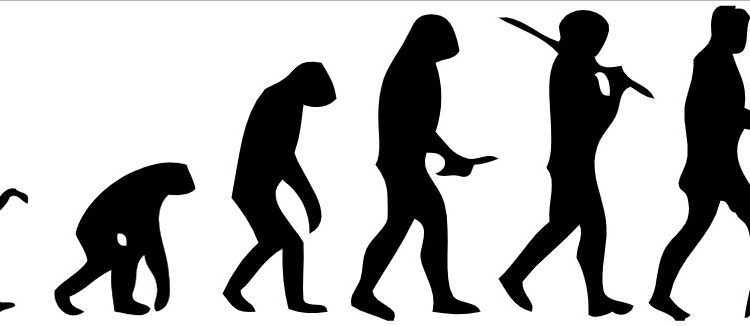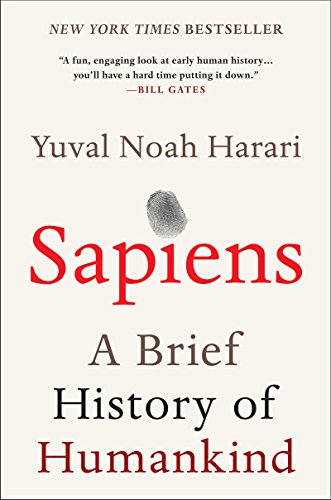

This article is an excerpt from the Shortform summary of "Sapiens: A Brief History of Humankind" by Yuval Noah Harari. Shortform has the world's best summaries of books you should be reading.
Like this article? Sign up for a free trial here .
In Sapiens, Yuval Noah Harari uses concepts from physics, chemistry, biology, and history to tell the story of us, Homo sapiens, and the history of human evolution.
The history of early human evolution is punctuated by advances in language and technology, and the evolution has been both biological and social. Some social advantages started out as biological disadvantages. We’ll look at each revolution and how it dramatically redirected the course of human history.
History of Human Evolution: Shared Characteristics of Humans
The evolution of mankind has been both biological and social. Let’s look at what all the human species had in common.
Characteristic #1: Large Brains
One of the biggest evolutions of human species evolution had to do with the brain. Mammals that are 130 lbs typically have a brain that’s an average of 12 cubic inches. In contrast, the brains of early humans were 36 cubic inches. Today, our average brain size is 73-85 cubic inches, and the brains of Neanderthals were even bigger than ours.
It seems like large brains would give us and our fellow humans an obvious advantage over other animals, but it wasn’t necessarily an asset to early humans.
The Disadvantages of a Big Brain
Big brains take a lot of energy to fuel. Our brains make up 2-3% of our body weight, but use 25% of our energy. (The brains of our ape siblings only use 8% of their energy.)
This drain of energy caused two main problems:
- Problem #1: Humans had to spend a lot of time searching for food (they needed a lot of calories to feed their hungry brains).
- Problem #2: Their muscles atrophied because their bodies had to divert energy from muscles to feed the brain.
When you’re in the middle of the food chain, trying to catch small animals and keep out of the way of big ones, using your energy to power your brain instead of your muscles isn’t the smartest strategy.
We still don’t really know why we evolved such large brains when there was little use for them in the early history of human evolution. It was a bad use of our energy.
Characteristic #2: Walking Upright
Like having a big brain, walking upright seems like an unequivocally positive trait to us today, in part because we still walk upright and can’t imagine moving any other way. There were both advantages and disadvantages to walking upright.
Pros:
- A better view: When you’re standing, it’s easier to see the lion hiding in the grass or the prey oblivious to you.
- The ability to use tools: When you don’t need your arms for moving around, they’re freed up for other tasks, like signaling to others and using tools. As we evolved more nerve endings and agile muscles in our hands, our tools became more sophisticated.
Cons:
- An unstable skeleton: Because we’re built to walk on all fours like most mammals, our skeletal structure doesn’t easily support our large heads. Consequently, we get back and neck aches.
- Narrow hips: To walk upright, women (and men) evolved narrower hips, but this was bad news for childbirth. As women’s hips were getting narrower, babies’ heads were getting bigger.
Narrow hips especially had far-reaching consequences for the history of human evolution, creating a domino effect that led to helpless babies. This was because the women who survived the dangerous activity of childbirth (and continued to pass on their genes through subsequent births) were the ones who gave birth early in the fetus’s gestation, when the baby’s head was smaller and undeveloped.
Consequently, women evolved to give birth earlier when the fetus is less developed. This means that human infants are undeveloped and helpless compared with other animal infants. For instance, a colt can start to run soon after birth, and a kitten finds food on its own after a few weeks. But human children are dependent on their parents for years.
The fact that human children were vulnerable for years after birth meant that human adults had to care for and protect them for years. Like having a big brain, this wasn’t an obvious advantage for early human evolution. Humans needed their energy for activities like escaping the jaws of larger, stronger animals.
The Consequences of Having Premature Babies
Despite the risks involved in caring for vulnerable infants, their existence created unique social situations for humans. These situations and the resulting societal bonds may have contributed to the rise of human dominance in the animal kingdom. This was a consequence of the unique evolution of mankind.
There were two unique results of human children being born prematurely:
Result #1: The “It Takes a Village” Mentality: Because children were so helpless, mothers relied on family members and neighbors to raise them. Many other animal genera (plural of “genus”) didn’t have the need to form these social bonds.
Result #2: The Potential for Socialization: Children born relatively helpless are (relative) blank slates. As such, their societies can shape them through education and socialization to be whatever they want them to be. Whereas other mammals are born like glazed earthenware coming out of the kiln (if you try to reshape them, they’ll break), humans are born like molten glass, easily formed and reformed.
Evolution of Mankind: Last Man Standing
We shared much in common with our fellow humans. How did we rise from the middle of the food chain to the top? And how did we become the last humans standing?
Fire
The domestication of fire changed the game, giving humans power over the natural world that no other animal possessed. Fire was a source of light. It was warmth in the cold months and a weapon in moments of conflict. You could even use fire to burn through impassable underbrush, changing the landscape to fit your needs.
The most important use of fire was cooking. Cooking food made it easier to digest. Since digestion was easier, the long intestine became shorter. This development was especially important. Big brains and big intestines both use a lot of energy. By allowing humans to better digest food and evolve shortened intestines, fire may have indirectly contributed to the brain getting a greater share of the body’s energy. As the brain got more energy, it got bigger.
When humans mastered fire, they finally gained a key to developing dominance over animals that were stronger and faster than they were. This was a major moment in the history of human evolution.
Why Are We the Only Humans Left?
Sapiens wasn’t the only species that used fire. Why did it come to dominate?
The current evidence leaves us with two options to explain the disappearance of other humans.
- Option #1: Due to their superior tools and collaboration skills, Sapiens were better hunters and gatherers, and as they migrated to new geographic areas, they out-competed the human species that originally called that area home. Neanderthals, who were less resourceful, had trouble feeding themselves, and they slowly died out.
- Option #2: Genocide. Modern Sapiens have fought wars with others because of their differences in skin color, culture, and religious beliefs. Would Sapiens be any more tolerant of humans of an entirely different species? Or maybe it was their familiarity that motivated Sapiens to kill their fellow humans. Perhaps other humans, particularly the Neanderthals, were too similar to Sapiens. Neanderthals were a threat to a species that wanted to dominate the animal kingdom.
What made Sapiens the superior species that pushed other humans to extinction? Harari argues the most likely answer is language. We’ll cover that next.
The Cognitive Revolution
One of the biggest most moments in the history of human evolution was the Cognitive Revolution. 2.5 million years ago, Homo sapiens was just one of eight human species. The first major revolution for Sapiens was the Cognitive Revolution 70,000 years ago. Before that point, Sapiens weren’t particularly special and weren’t superior to the other seven human species. The Cognitive Revolution involved the development of three new abilities, all related to language, that helped Homo sapiens outpace their fellow humans.
Ability #1: Flexible Language
One reason the language of Sapiens was different was that it was more complex. Rather than communicating simple ideas the way green monkeys do (“Careful! A lion!” or “Careful! An eagle!”), the language of Sapiens could warn someone about a lion, describe its location, and plan how to deal with it. This allowed them to plan and follow through on complex actions like avoiding predators and working together to trap prey.
Ability #2: Gossip
A second distinction of the Sapiens language was its ability to convey gossip. We think of gossip as a bad thing, but using language to convey information about other people is a way to build trust. Trust is critical for social cooperation, and cooperation gives you an advantage in the struggle to survive and pass on your genes. Sapiens could form groups of up to 150 people. They didn’t need to know every group member personally to trust them. In a battle, a small group of Neanderthals was no match for a group of 150 Sapiens.
Ability #3: Fictions
A third benefit of the Sapiens’ language was how it was used to create fictions, also known as “social constructs” or “imagined realities.”
Being able to communicate information about things that don’t exist doesn’t seem like an advantage. But Sapiens seem to be the only animals who have this ability to discuss things that don’t have a physical presence in the world, like money, human rights, corporations, and God.
Collective Fictions
In and of itself, imagining things that don’t exist isn’t an asset—you won’t aid your chances of survival if you go into the forest looking for ghosts rather than berries and deer.
What’s important about the ability to create fictions is the ability to create collective fictions, fictions everyone believes. These collective myths allow people who’ve never met and otherwise would have nothing in common to cooperate under shared assumptions and goals.
Although imagined, these myths are crucial. Without collective fictions, the systems built on them collapse. And as we’ll see, most of our modern systems are built on these imagined realities. These myths are powerful, and the fact that they’re not rooted in objective reality doesn’t undermine them.
Collective fictions allowed early Sapiens to cooperate within extremely large groups of people, most of whom they’d never met, and it rapidly changed their social behavior.
Genetic Evolution Versus Social Evolution
The history of human evolution has been both genetic and social. Usually, it takes a genetic mutation to significantly change behavior, and that takes hundreds, if not hundreds of thousands, of years.
For example, common chimpanzees live in hierarchical groups led by the alpha male, whereas their relatives the bonobos live in egalitarian groups led by females. Chimps can’t suddenly decide that they too want to live in an egalitarian society. Their social behavior is ingrained in their genes. Such a change would have to come from their DNA.
Until the Cognitive Revolution, the social and technological evolution of Sapiens also depended on changes in DNA. But the Cognitive Revolution—and the language, collective fictions, and cooperation it brought with it—allowed Sapiens to evolve much faster than other humans. We can now change our social structures, interpersonal behavior, and economic behavior within decades, rather than over hundreds of years.
Example: The Power of the Pope
We can see how the advent of “fictions” made social evolution independent of biological evolution in the example of the Pope. Social evolution is a major aspect of human species evolution.
In the societies of our chimp relatives, the alpha male uses his position of power to mate with as many females as possible, ensuring that he passes his genes to the next generation. In the animal world, this is the primary, instinctive goal—to survive long enough to pass on your DNA and keep your ancestral line alive. The sole purpose of gaining power is to help you survive and procreate.
However, in modern human societies, power is divorced from procreation and institutions are passed along not through genes but through fictions.
For example, Catholic priests, Buddhist monks, and Chinese eunuchs all hold sway over their societies. They’re also meant to be celibate. Their celibacy isn’t the result of limited resources or a lack of females. It’s also not the product of a genetic mutation.
There’s no genetic basis or survival need for the Catholic Church, but it hasn’t died out. It’s passed from one generation to the next via stories rather than genes. Social evolution has been a major part of the history of human evolution.
———End of Preview———

Like what you just read? Read the rest of the world's best summary of "Sapiens" at Shortform . Learn the book's critical concepts in 20 minutes or less .
Here's what you'll find in our full Sapiens summary :
- How Sapiens outlived and outlasted the 8+ other human-like species on Earth
- The 3 critical revolutions in human existence that led to our domination of the planet
- How much of what powers our world today is really just a shared mass delusion
- What the future of humanity might look like






